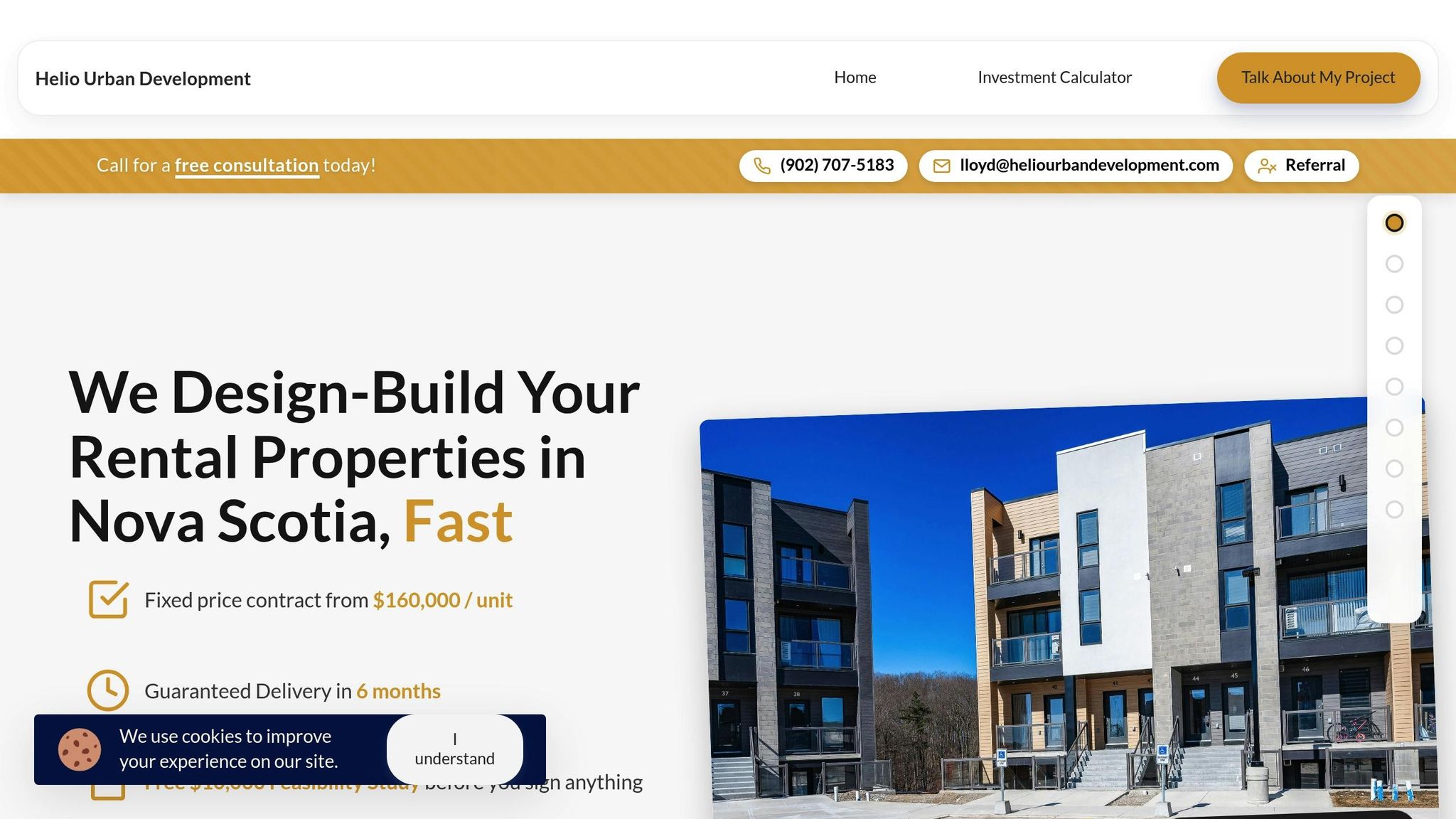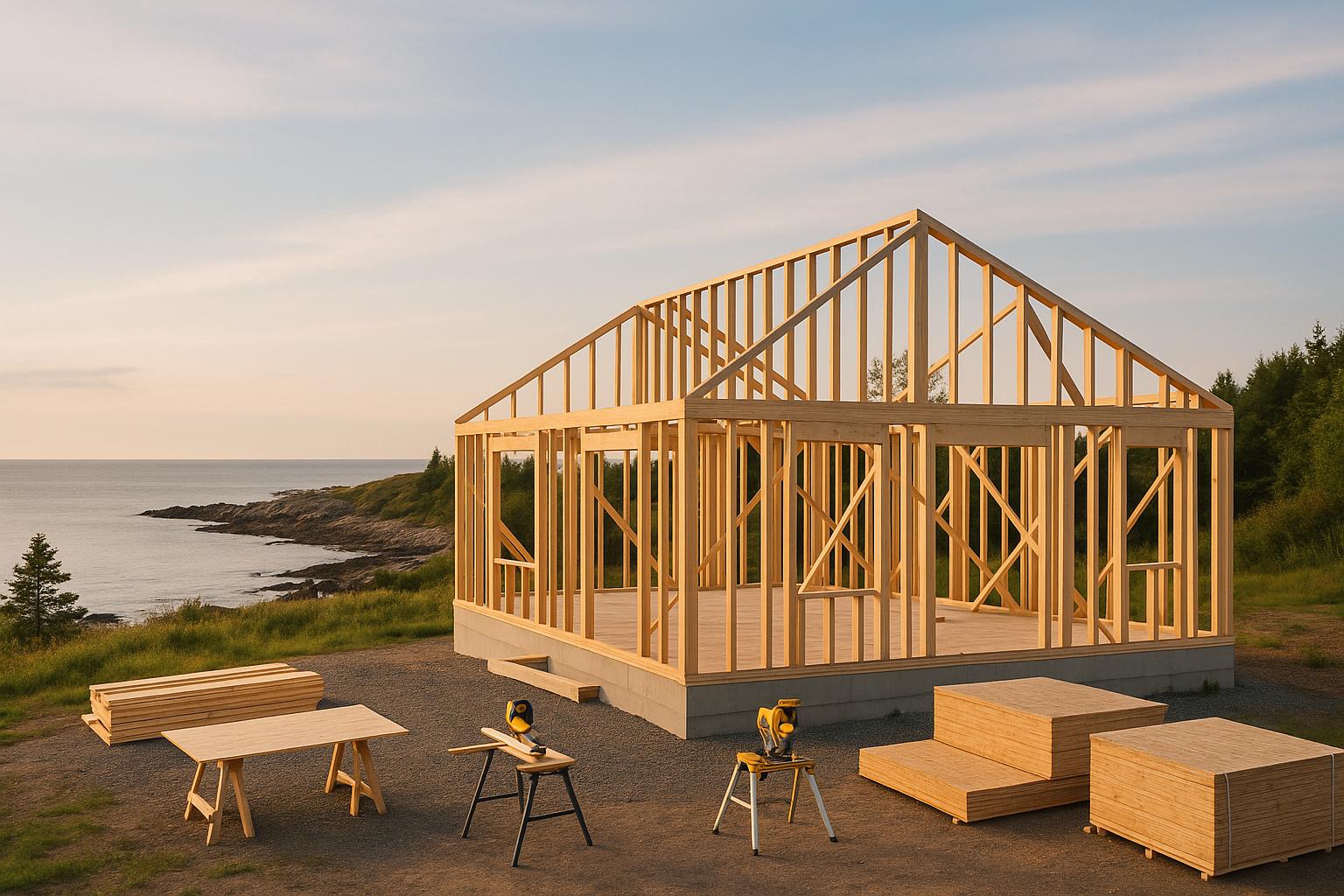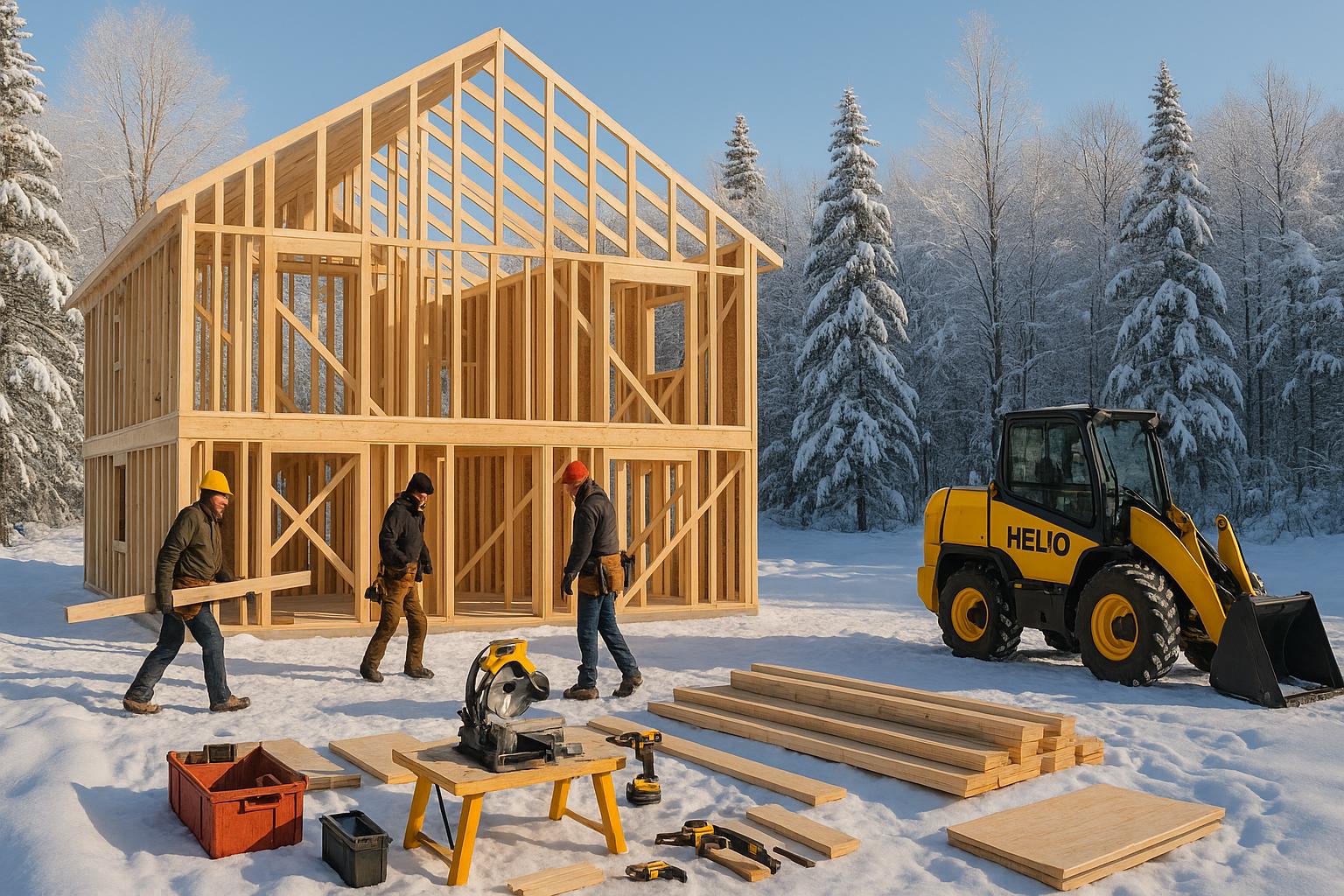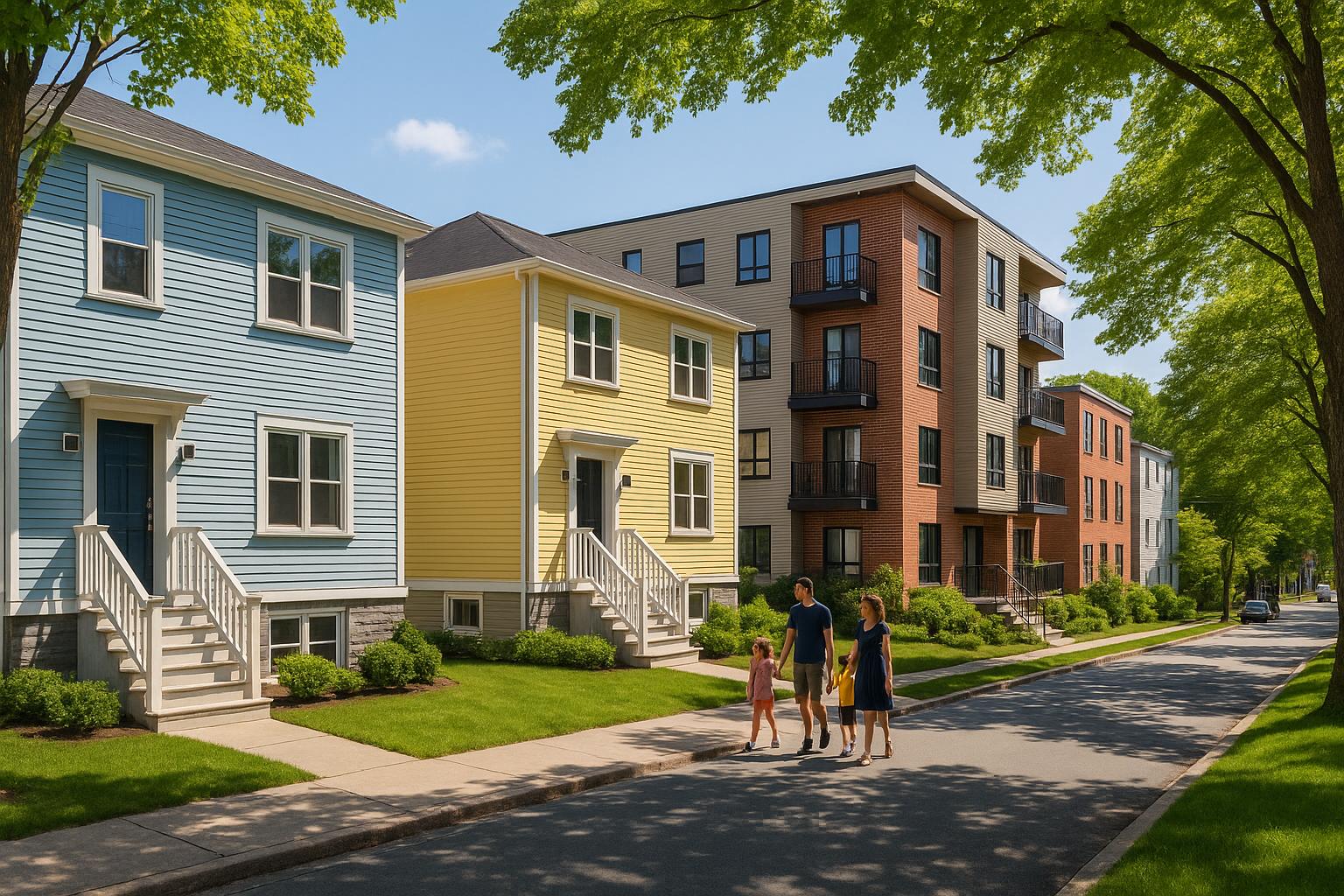The new ER-3 zoning rules in Halifax simplify small multi-unit housing development by addressing long-standing challenges like restrictive Floor Area Ratio (FAR) limits and unpredictable approval processes. Now, property owners can build up to 8 units per lot, with clear guidelines for density, design, and approvals. These changes reduce delays, lower costs, and improve project timelines, making rental property development more accessible.
Key Updates with ER-3 Zoning:
- Units per Lot: Up to 8 units allowed on lots ≥800 m².
- Building Height: Capped at 11 metres.
- Approval Timelines: Reduced from 6–18 months to 2–6 months.
- Design Standards: FAR limited to 0.8 for neighbourhood fit.
- Flexibility: Rear additions and internal conversions now easier.
HALIFAX Home Owners May Have Just Won THE LOTTERY : Halifax Proposed Zoning Changes January 2024
ER-3 Zoning Features That Help Property Owners
ER-3 zoning brings in several updates designed to support efficient multi-unit development on existing residential lots.
Density and Building Options
Under ER-3 zoning, property owners can build up to 8 units per lot, provided the lot is at least 800 m². Each unit requires a minimum of 100 m², while the maximum building height is capped at 11 metres, and the lot coverage cannot exceed 40% of the total area[2]. This zoning focuses on the number of units rather than the number of bedrooms, offering more flexibility in design and layout.
Neighbourhood Fit and Design Rules
To maintain the character of established neighbourhoods, ER-3 zoning includes design guidelines. The Floor Area Ratio (FAR) is limited to 0.8, ensuring that the size of the building remains in proportion to the lot size[2]. These rules aim to balance increased density with the need to preserve the residential feel of the area.
How ER-3 Makes Multi-Unit Construction Easier
The transition from Halifax's old zoning rules to ER-3 has simplified multi-unit construction, offering property owners a more predictable and efficient process. Where uncertainty and delays once plagued projects, ER-3 introduces clear guidelines and timelines that make planning and building far smoother. Here's a closer look at how these changes address the key challenges faced by property owners.
Before ER-3 vs. With ER-3 Comparison
The table below illustrates the major differences between the old zoning system and the new ER-3 zoning, highlighting how it has made multi-unit construction more accessible:
| Factor | Before ER-3 | With ER-3 Zoning |
|---|---|---|
| Unit Limit | 2–3 units (typical) | Up to 8 units per lot |
| Approval Process | Discretionary, unpredictable | Streamlined, clear criteria |
| Building Types | Limited (single/duplex) | Townhouses, small apartments, suites |
| Design Standards | Vague, subjective | Clear, low-rise standards |
| Construction Risks | High (delays, redesigns) | Lower (predictable process) |
| Rental Income Potential | Limited | Increased significantly |
| Flexibility | Low | High (mixed uses, conversions) |
One of the standout changes is the dramatic reduction in approval timelines. What used to take 6–18 months can now be completed in 2–6 months, thanks to ER-3's unified criteria. This shift has replaced the uncertainty of the old system with a much-needed sense of predictability.
Another game-changer is the removal of limits on rear additions and internal conversions. Under ER-3, property owners can now convert existing structures into multiple rental units without the red tape that previously made such projects nearly impossible[3].
Addressing Common Construction Challenges
While the table highlights the broad benefits of ER-3, it’s important to dive deeper into how the new zoning rules tackle specific issues that once plagued property owners. Before ER-3, three major hurdles often derailed multi-unit construction projects: coordination chaos, budget overruns, and timeline delays. ER-3 directly addresses each of these problems.
Coordination Chaos: Previously, property owners had to juggle multiple contracts across various disciplines, leading to miscommunication and costly delays. Design changes often sparked disagreements among trades, further complicating projects. With ER-3’s clear design standards, the need for constant revisions is significantly reduced. This allows construction teams to work more cohesively, delivering projects on schedule.
Budget Overruns: Financial planning was a nightmare under the old system, with cost overruns ranging from 30–60%. For example, a project initially estimated at $500,000 could easily balloon to $750,000 or more. ER-3’s standardized requirements now allow builders to provide accurate, fixed-price quotes, as municipal standards are clearly defined from the start.
Timeline Delays: Delays were another common issue, with 8-month projects often stretching to 18 months or more. These delays not only increased costs but also resulted in significant lost rental income. ER-3’s predictable approval process helps keep construction timelines realistic - often around six months - by eliminating mid-project requirement changes.
The "gentle density" approach championed by ER-3 reflects a growing trend across Canada towards increasing multi-unit housing in established neighbourhoods[3][4]. This approach ensures that property owners can undertake projects with municipal backing, creating a more collaborative environment.
For those working with integrated design-build teams, ER-3 offers even greater advantages. Builders can now guarantee fixed costs and timelines, as the zoning requirements are clear from the outset. This eliminates the sudden changes that once disrupted projects and provides property owners with much-needed peace of mind.
Design-Build Solutions for ER-3 Projects
ER-3 zoning provides a clear and predictable framework, making it a natural fit for integrated design-build strategies. With well-defined municipal requirements, developers can confidently commit to fixed prices and timelines. This zoning clarity is reshaping multi-unit construction in Halifax.
Regular Construction vs. Design-Build
Traditional construction methods often add unnecessary complexity to ER-3 projects. Developers may need to juggle six or more separate contracts, leading to delays, miscommunication, and inefficiencies. Each professional - whether an architect, engineer, or contractor - operates independently, often on conflicting schedules. This fragmented approach can result in blame-shifting when problems arise, delaying solutions.
The design-build model offers a much-needed alternative by combining design and construction into a single, unified process. In this approach, one team or contractor oversees the entire project, ensuring seamless collaboration between architects, engineers, and builders from start to finish [5][6]. This eliminates the coordination headaches of traditional methods.
With design-build, there’s a single point of accountability. If questions or changes come up, there’s no confusion about who’s responsible. This clarity simplifies communication and speeds up decision-making.
Financially, the benefits are hard to ignore. Design-build teams provide fixed pricing and faster timelines, helping to avoid unexpected costs or delays. Early collaboration between owners and design-build teams ensures better planning around project design, budget, and schedule, saving both time and money [5][6]. By overlapping design and construction phases, this method also shortens the overall project timeline, allowing multi-family developments to hit the market sooner.
Another major advantage is risk management. Design-build shifts much of the project risk - like costs from design errors or construction delays - onto the contractor. This provides property owners with greater certainty in both costs and timelines, which is crucial for planning rental property investments.
This streamlined approach is the foundation of Helio Urban Development’s success in ER-3 projects.
Why Helio Urban Development Works Well for ER-3 Projects

Helio Urban Development’s integrated design-build model is perfectly suited to ER-3 zoning. As Nova Scotia’s only design-build company focused exclusively on 4+ unit rental properties, Helio eliminates the confusion and inefficiencies that often plague multi-unit construction projects.
Helio offers a fixed-price model of $160,000 per unit, covering all specifications upfront. This includes features like ductless heat pumps, triple-pane windows, quartz countertops, engineered hardwood flooring, and high-quality fixtures. This level of transparency ensures property owners know their exact costs before construction begins. To date, Helio has completed projects without a single cost overrun.
ER-3’s predictable approval process also allows Helio to commit to strict timelines. The company guarantees project completion within six months and imposes financial penalties of up to $1,000 per day for missed deadlines. This reliability gives owners the confidence to plan rental income accurately, with typical units generating monthly rents of $1,950 to $2,100.
Helio also emphasizes transparency through real-time project portals. These tools allow owners to monitor every stage of construction remotely, removing the uncertainty that often comes with building projects.
Serving municipalities within a 90-minute radius of Halifax, Helio has already proven the scalability of its approach. With 31 units under construction and another 131 in planning, the company is demonstrating how effectively the design-build model works for ER-3 projects.
Quality control is a top priority, ensured through a triple verification system: a Professional Engineer conducts five inspections during construction, owners select their final inspector, and all work is backed by a two-year warranty. This rigorous process ensures construction meets the highest standards.
For owners looking to maximize financing, Helio offers CMHC MLI Select construction at $200,000 per unit. These builds are 40% more energy-efficient than standard code requirements, enabling owners to access 95% financing with 50-year amortization options. While the upfront cost is higher, the improved energy efficiency boosts cash flow and allows for more units to be built with the same capital.
By 2026, nearly half of all construction spending is projected to follow the design-build model [5]. In Halifax, ER-3 zoning is driving this trend, as property owners increasingly see the benefits of an integrated approach to rental property development.
Steps for Property Owners to Use ER-3 Zoning
The introduction of ER-3 zoning has made it easier for property owners to develop rental properties by reducing regulatory barriers. With streamlined project approvals, you can now take advantage of this zoning to turn your property into a successful rental development.
Step-by-Step Guide to Start Your ER-3 Project
Confirm Your Property's ER-3 Eligibility
The first step is to verify whether your property falls under the ER-3 zone. You can do this using the Halifax Regional Municipality's (HRM) mapping system. Thanks to updates under the Housing Accelerator Fund, properties in ER-3 zones can now accommodate up to 8 units and 4 storeys (12 metres in height) as-of-right. This means that as long as your project complies with zoning regulations, you’ll only need standard municipal approvals - no additional council action is required[1].
Assess Your Lot's Development Potential
Take a close look at your lot’s dimensions, shape, and orientation. Pay attention to setback requirements, parking needs, and how your project fits into the surrounding neighbourhood. A professional assessment can help you determine the optimal number of units your lot can support while staying within ER-3 guidelines.
Secure Pre-Construction Financing and Finalize Your Contract
Before moving forward, arrange pre-construction financing with your bank or mortgage broker. Construction loans typically require a down payment of 20–25% for standard projects. However, programs like CMHC MLI Select may offer financing options with as little as 5% down, covering up to 95% of the project cost. Getting pre-approval helps define your budget and demonstrates readiness to builders. When finalizing your construction contract, ensure it includes fixed pricing, guaranteed timelines, and detailed specifications to avoid unexpected costs or delays.
Choose an Integrated Design-Build Team
Opt for a design-build team that manages all aspects of the project under one roof. This approach simplifies coordination, keeps your project on schedule, and ensures compliance with ER-3 zoning regulations.
Navigate Municipal Approvals
Submit your permit application through HRM. Since ER-3 projects that meet zoning standards are processed as-of-right, the approval process is generally more straightforward and predictable. Your design-build team should ensure your application meets all municipal requirements to avoid unnecessary delays.
Monitor Construction Progress
Stay actively involved during construction by keeping track of progress through site visits and updates. Many integrated builders provide daily photo updates or online project portals, allowing you to monitor developments remotely and address any issues promptly.
Checklist for Choosing the Right Builder
Selecting the right builder is critical to ensuring your ER-3 project is completed smoothly and on budget. Use this checklist to evaluate potential builders:
- Experience with Multi-Unit Rentals: Look for builders with a track record of 4+ unit rental properties. Request examples of past projects and speak with previous clients.
- Fixed-Price Contracts: Choose a builder who offers fixed pricing in their contracts. Avoid cost-plus arrangements, which can lead to unexpected expenses.
- Guaranteed Timelines: Select a builder who commits to specific completion dates and includes penalties for delays in their contract.
- Knowledge of ER-3 Zoning: Ensure your builder is well-versed in ER-3 zoning requirements and HRM’s development process.
- Quality Control: Verify that the builder has strong quality control systems, including third-party inspections and comprehensive warranties.
- Local Expertise: Work with a builder who understands Halifax’s municipal regulations and market conditions.
- Financial Stability: Check references and confirm the builder’s history of delivering projects on time and within budget.
- Clear Communication: Choose a builder who provides regular updates and maintains transparent communication throughout the project.
A skilled builder can simplify the complexities of ER-3 zoning, turning it into an opportunity for profitable rental property development. By carefully choosing your partners, you can ensure your project stays on track and achieves its investment goals.
sbb-itb-16b8a48
Conclusion: ER-3 Opens New Development Opportunities in Halifax
The introduction of ER-3 zoning is a game-changer for Halifax, addressing long-standing challenges in multi-unit development. By allowing up to eight units on lots previously restricted to single-family homes and permitting buildings up to 12 metres tall[7], it directly tackles the "missing middle" housing gap. This shift paves the way for a more efficient and inclusive construction model.
However, zoning changes alone won't guarantee success. The construction method you choose will play a crucial role. Traditional, fragmented approaches - where multiple parties handle different aspects - often lead to budget overruns of 30–60% and delays ranging from 8 to 18 months. These inefficiencies can derail even the most promising projects.
On the other hand, a design-build approach simplifies the process by consolidating all aspects under one umbrella. A great example of this is Helio Urban Development, which has consistently delivered fixed-price construction at $160,000 per unit, completed in just six months, and without cost overruns.
By combining ER-3’s streamlined zoning standards with the efficiency of a design-build model, rental property investments can reach new heights. This approach not only accelerates project timelines but also enhances monthly rental income and annual returns. Successful ER-3 developments can provide steady, long-term income with reduced risk, predictable costs, and quicker approvals.
While ER-3 zoning opens the door to exciting opportunities, partnering with the right construction team is essential to fully realize its potential.
FAQs
How does ER-3 zoning affect the cost and timeline for building multi-unit residential properties in Halifax?
ER-3 Zoning in Halifax: A Game Changer for Rental Property Development
Halifax's ER-3 zoning is transforming how rental properties with four or more units are built. By cutting through the usual hurdles, it trims both costs and timelines for property owners. On average, developers can save around $47,000, thanks to reduced barriers and a smoother approval process.
Beyond the financial perks, ER-3 zoning speeds up project timelines by allowing higher density and cutting down on bureaucratic delays. This streamlined approach helps property owners move quickly from the planning stage to construction, offering a more straightforward and efficient path to getting projects completed.
How does the design-build approach simplify ER-3 projects compared to traditional construction methods?
How the Design-Build Approach Simplifies ER-3 Projects
The design-build method combines the design and construction phases into a single, streamlined process, making it a game-changer for ER-3 projects. Unlike traditional approaches - which often require juggling multiple contracts and can stretch timelines to 12–18 months - design-build simplifies the workflow and can deliver results in as little as six months.
This method comes with several advantages: fixed costs, clear accountability, and a smoother, more predictable process for property owners. By handling everything under one roof, it eliminates the hassle of coordinating separate teams and contracts. The result? Fewer delays and more efficient project management. It’s a smart option for anyone looking to develop 4+ unit rental properties within Halifax’s ER-3 zoning.
How does ER-3 zoning help property owners overcome past challenges in building multi-unit housing in Halifax?
ER-3 Zoning in Halifax: A Game Changer for Housing Development
Halifax’s ER-3 zoning is reshaping how property owners approach multi-unit housing development. By tackling obstacles like restrictive zoning rules and time-consuming approval processes, this zoning allows for up to eight units per lot. It also removes parking requirements, paving the way for higher-density housing in established neighbourhoods.
This shift cuts through bureaucratic delays and opens doors for more affordable housing options. It empowers property owners to play a direct role in addressing Halifax's housing shortage while making the most of their land’s potential.



